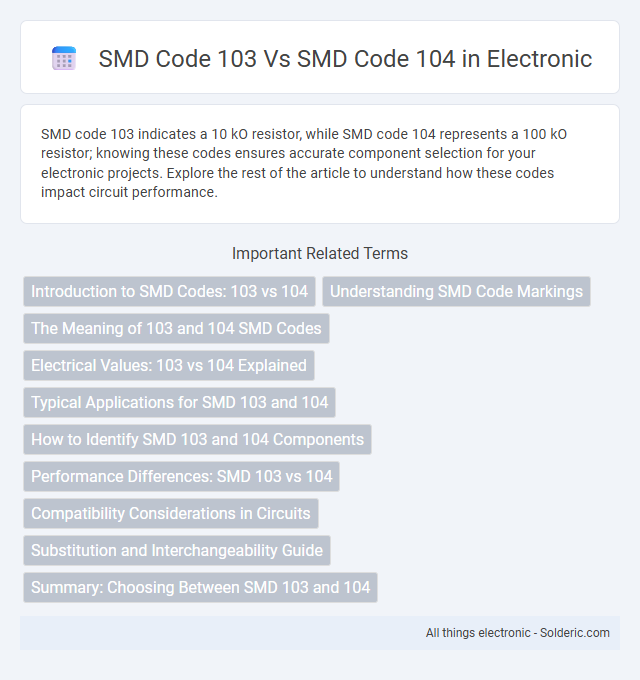SMD code 103 indicates a 10 kO resistor, while SMD code 104 represents a 100 kO resistor; knowing these codes ensures accurate component selection for your electronic projects. Explore the rest of the article to understand how these codes impact circuit performance.
Comparison Table
| Specification | SMD Code 103 | SMD Code 104 |
|---|---|---|
| Capacitance Value | 10 nF (nanofarads) | 100 nF (nanofarads) |
| Capacitance Code Meaning | 10 x 103 pF = 10,000 pF = 10 nF | 10 x 104 pF = 100,000 pF = 100 nF |
| Typical Use | Filtering, decoupling in low-frequency circuits | Higher-frequency filtering, decoupling, timing circuits |
| Package Size | Varies (common: 0805, 0603) | Varies (common: 0805, 0603) |
| Voltage Rating | Typically 16V-50V | Typically 16V-50V |
| Dielectric Type | Ceramic (Class 2 or 3) | Ceramic (Class 2 or 3) |
Introduction to SMD Codes: 103 vs 104
SMD code 103 designates a 10kO resistor, characterized by a '10' followed by '3' zeros in ohms, while SMD code 104 represents a 100kO resistor with '10' followed by '4' zeros. These numeric codes provide a standardized method for identifying resistance values on small surface mount devices and are essential for precision in electronic circuit design. Understanding the distinction between code 103 and 104 ensures accurate component selection and optimal circuit performance.
Understanding SMD Code Markings
SMD code 103 and 104 represent specific capacitor values using a three-digit marking system, where the first two digits indicate the significant figures and the third digit denotes the multiplier in picofarads; 103 corresponds to 10,000 pF (0.01 uF), while 104 indicates 100,000 pF (0.1 uF). These codes are essential for quickly identifying a capacitor's capacitance on small surface-mount devices without the need for detailed datasheets. Understanding these SMD code markings improves component selection accuracy in electronic circuit design and troubleshooting.
The Meaning of 103 and 104 SMD Codes
SMD code 103 represents a capacitor with a capacitance of 10,000 picofarads (10nF), while SMD code 104 indicates a capacitance of 100,000 picofarads (100nF). These codes follow the standard three-digit notation, where the first two digits show significant figures and the third digit indicates the multiplier power of ten. Understanding these values helps you select the correct capacitor for your electronic circuit's performance and filtering needs.
Electrical Values: 103 vs 104 Explained
SMD code 103 represents a capacitance value of 10,000 pF (0.01 uF) with a tolerance typically around +-10%, while SMD code 104 indicates a capacitance of 100,000 pF (0.1 uF) often used in decoupling and filtering applications. Both codes follow the standard ceramic capacitor marking system where the first two digits signify significant figures and the third digit denotes the multiplier in picofarads. Electrical performance differences include higher charge storage capacity and slightly different frequency response due to the increased capacitance in the 104 code capacitor compared to the 103.
Typical Applications for SMD 103 and 104
SMD code 103 capacitors are typically used in filtering circuits and timing applications due to their 0.01uF capacitance, commonly found in signal processing and decoupling tasks. SMD code 104 components, with a 0.1uF capacitance, are preferred for power supply bypassing and noise reduction in high-frequency circuits and microcontroller-based designs. Both codes optimize surface-mount technology but cater to different capacitance needs for precise application requirements.
How to Identify SMD 103 and 104 Components
SMD code 103 represents a surface-mount resistor with a value of 10k ohms, identified by the digits "103," where "10" is the base value and "3" indicates three zeros. In contrast, SMD code 104 denotes a 100k ohm resistor, with "10" as the base value and "4" as the multiplier for four zeros. These codes are printed directly on the small rectangular component, enabling easy identification of their resistance values in electronic circuit designs.
Performance Differences: SMD 103 vs 104
SMD code 103 represents a 10kO resistor, while SMD code 104 corresponds to a 100kO resistor, indicating a significant difference in resistance values that directly impacts circuit performance. The lower resistance of SMD 103 allows higher current flow, making it suitable for applications requiring lower impedance, whereas SMD 104 limits current more effectively, essential for voltage division or signal conditioning tasks. Understanding these performance differences helps you select the appropriate resistor value to optimize your electronic circuit's functionality and efficiency.
Compatibility Considerations in Circuits
SMD code 103 represents a 10nF capacitor, while SMD code 104 corresponds to a 100nF capacitor, indicating a tenfold difference in capacitance that affects charge storage and filtering characteristics. Compatibility in circuits requires matching these capacitance values to ensure proper timing, frequency response, and noise suppression. Using a 103 capacitor in place of a 104 can lead to insufficient filtering or timing errors, making correct SMD code selection critical for circuit reliability and performance.
Substitution and Interchangeability Guide
SMD code 103 denotes a 10kO resistor, while SMD code 104 refers to a 100kO resistor, making direct substitution impractical due to a tenfold difference in resistance values. Interchangeability between these codes requires recalculating circuit parameters and ensuring the replacement resistor's tolerance and power rating match the original specifications to maintain circuit integrity. Engineers must consult detailed component datasheets for equivalent alternatives before considering SMD 103 and 104 as substitutes in electronic designs.
Summary: Choosing Between SMD 103 and 104
SMD code 103 refers to a 10nF (0.01uF) capacitor, while code 104 represents a 100nF (0.1uF) capacitor, with both values commonly used for decoupling and filtering in electronic circuits. Selecting between SMD 103 and 104 depends on the application's frequency response and capacitance requirements, where 104 offers higher capacitance for better noise suppression but 103 suits high-frequency stability. Engineers prioritize these values based on circuit impedance and desired transient response to optimize performance and reliability.
SMD code 103 vs SMD code 104 Infographic

 solderic.com
solderic.com